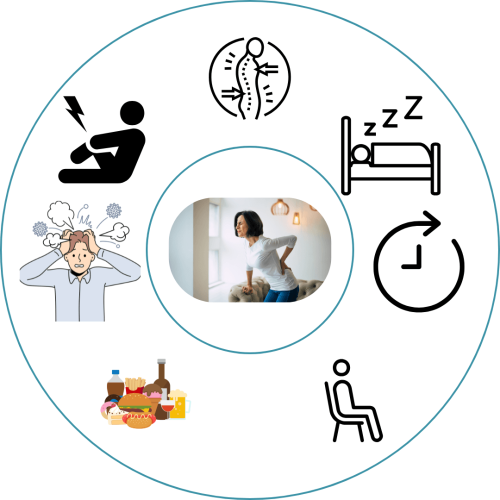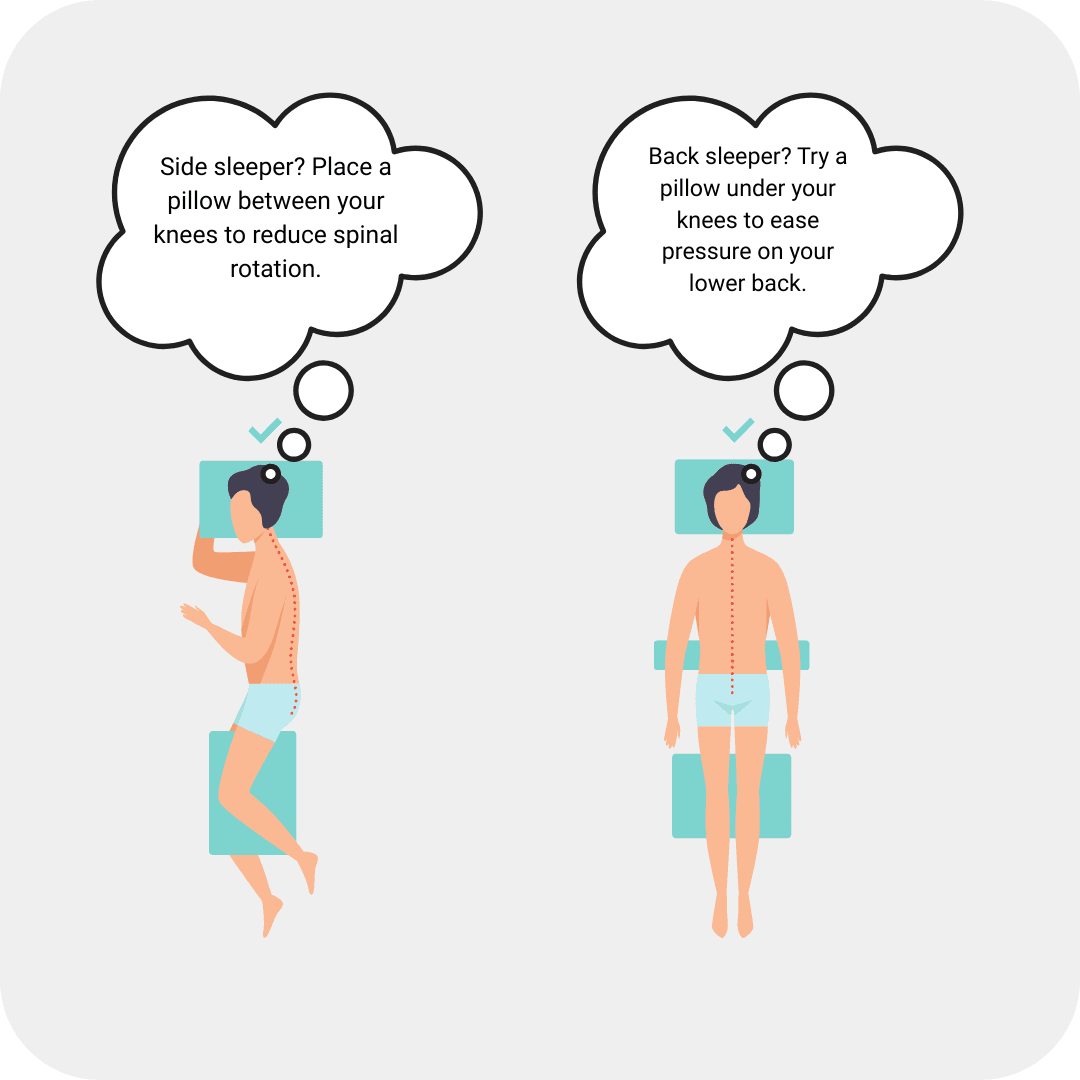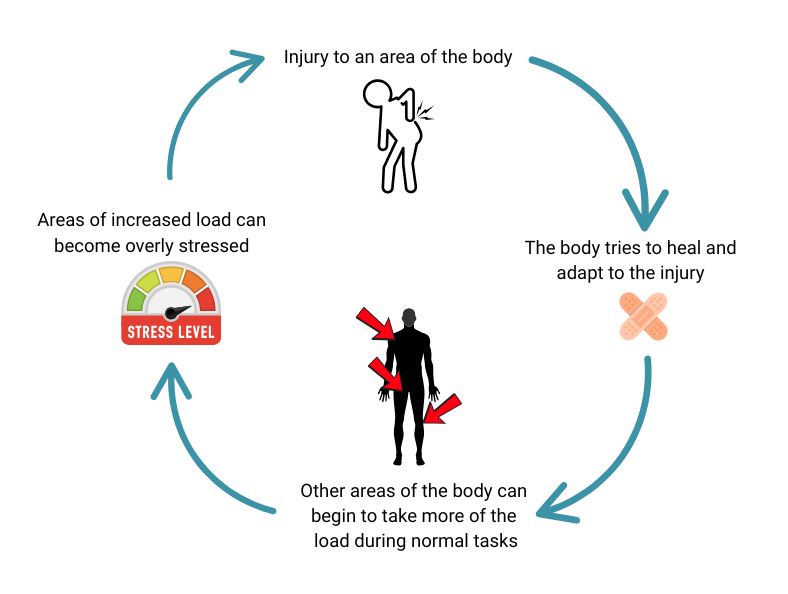
Do you ever wonder why your back still hurts—even though you haven’t injured it? That feeling of being twenty years older than you are, or realising you can’t do the same activities you used to—sound familiar? You’re not alone. Back pain is one of the most common reasons people seek help, yet its causes are often misunderstood. Many assume it must come from a specific event or injury, but for most people, the root cause is more subtle.
In reality, back pain is often the result of everyday habits: how you sit, move, sleep, and even how you respond to stress. In this blog, we’ll uncover seven common—but often overlooked—reasons your back might be hurting, and what you can start doing today to feel better.
You might be surprised at what’s really behind your pain—and how chiropractic care fits in.
Table of Contents
1. Poor Posture Over Time
You might not notice it at first—a slight slouch at your desk, a forward head position while scrolling your phone, or leaning to one side while working. But over time, these small posture habits can place ongoing stress on your spine and supporting muscles. The result? Tight shoulders, a sore lower back, and a neck that always feels stiff.
When you slouch or hunch forward, your spine loses its natural alignment. Muscles at the front of your body tighten, while those at the back are overstretched and weakened. This imbalance can increase the risk of muscle fatigue, tension, and joint strain—even if you haven’t had an obvious injury. For a deeper dive into improving posture, read our blog on posture habits.

➤ “Quick Posture Fix: Sit tall, shoulders relaxed, chin tucked slightly—ears aligned over shoulders.”
2. Workplace Ergonomics Matter – But So Does Movement
You’ve probably been told to “sit up straight” to avoid back pain—but recent research challenges the idea that there’s a single “perfect” posture for everyone. In fact, what matters most isn’t what position you’re in—but how long you stay in it.
People without pain often sit in a relaxed, even slouched, posture—and posture naturally changes as we age, regardless of pain. This tells us that discomfort is more likely to come from staying static, not necessarily sitting or standing “wrong.” So while poor posture over time can lead to strain, the real issue is often the lack of movement between postures, not the position itself.
That’s where ergonomics come in. A good setup isn’t about locking yourself into one “correct” position—it’s about supporting comfortable, changeable postures that encourage regular movement.


3. Could Your Diet Be Affecting Your Back?

When thinking about back pain, most people focus on posture, injuries, or how active they are—but very few consider the role of what they fuel themselves with. What you eat can influence inflammation, tissue healing, and even how your spine and supporting muscles function.
A diet high in ultra processed foods, added sugars, and unhealthy fats may promote chronic low-grade inflammation in the body, which can contribute to and increase pain—especially if you’re already dealing with joint or muscular stress.
On the other hand, nutrients like omega-3 fatty acids, vitamin D and B12, magnesium, and antioxidants play a role in supporting muscle recovery, bone health, and reducing inflammation. Click here to read: Am I eating what I should
Hydration matters too. Dehydrated tissues become less resilient, which can affect the cushioning between your spinal joints and contribute to stiffness or discomfort—especially in the morning.
4. Stress Isn’t Just in Your Head—It’s in Your Back Too
When life feels overwhelming, your body often feels it too. And I get it—you’re likely reading this thinking, “Okay, but it’s just been a tough day at work. I’ll be fine.” And you’re probably right—in the short term, you will be. We’re incredibly resilient.
And here’s the thing: while we can cope with a lot of life’s ups and downs, stress doesn’t just affect our mood—it shows up in your muscles. Many people carry tension in their neck, shoulders, or lower back without even realising it. We compensate and adapt to changes in our lives, until one day the body says, “That’s enough.”
Physiologically, stress triggers the body’s fight-or-flight response, increasing muscle tension, reducing circulation, and heightening pain sensitivity. Over time, chronic emotional stress can lead to ongoing tightness, stiffness, and postural changes—all of which contribute to back pain.
🧠 Here’s a quick exercise:
Put yourself in the posture of someone who’s very unhappy. Then try the posture of someone who’s happy and confident.
What did you change? Comment below—I’d love to hear what you noticed.
You might also find your breathing becomes shallower when stressed. That can impact your rib cage movement and core stability, adding more load to your spine.
📌 Tip: Try incorporating stress-reducing practices like diaphragmatic breathing, gentle stretching, or mindfulness during the day.
A good starting point is box breathing:
- Inhale through your nose (5 seconds)
- Hold (5 seconds)
- Exhale through pursed lips (5 seconds)
- Hold (5 seconds)
- Repeat for five cycles. Even a few deep breaths can help reset your nervous system and ease muscle tension.
5. The Way You Sleep Might Be Hurting Your Back
Ever woken up feeling more sore than when you went to bed? You’re not imagining it—your sleep setup can have a big impact on your back. Whether it’s your mattress, pillow, or sleeping position, small changes can affect how your spine is supported overnight.
Here’s something most people don’t realise: while you sleep, your spine naturally reabsorbs fluid into the discs. This happens because lying down reduces the effects of gravity and allows the discs between your vertebrae to rehydrate and expand slightly. It’s why you’re a little taller in the morning—and also why you might feel stiffer for the first 30 minutes after waking.
Your body also performs important repair processes during sleep, so if you’re not getting enough rest, you might be missing out on essential recovery time. And as we’ve already explored, nutrition and hydration can also affect how stiff or achy your body feels when you wake up.
Certain positions—like sleeping on your stomach—can place your neck and lower back in awkward angles for hours. Even side sleeping without proper pillow support between the knees can cause your hips and spine to rotate, increasing strain across your lower back.
Your mattress plays a big role too. A mattress that’s too soft can let your spine sag, while one that’s too firm may create pressure points. The goal is to keep your spine supported in a neutral position—not perfectly straight, but comfortably aligned.

6. Old Injuries or Underlying Issues You Might Not Know About
Sometimes back pain seems to come out of nowhere—but that doesn’t always mean nothing’s going on. Previous injuries—even ones that “healed” years ago—can quietly influence how your body moves today. Scar tissue, altered movement patterns (like how you sit, stand, or climb the stairs), and protective muscle tension can all linger long after the pain has faded.
You may also have undiagnosed issues like mild scoliosis, disc degeneration, or joint dysfunction that don’t show up until they’re aggravated by daily habits, poor movement, or prolonged stress. It’s not uncommon for people to brush off these aches, thinking, “I didn’t do anything to cause this,” or “It’ll go in a day or two.” But in reality, the discomfort may be the accumulation of small compensations over time.
As we’ve already said, we’re incredibly resilient—but that doesn’t mean we should wait and see. Why not explore the possibilities now, before it becomes something bigger?
📌 Tip: If your back pain is recurrent, one-sided, or doesn’t improve with simple changes, it’s worth getting assessed by a chiropractor or another qualified healthcare professional. Identifying patterns early can make a big difference in how you feel long term.

7. Restrictions in the Spine
Sometimes, despite trying to change your posture, go to the gym, sleep better, and eat well, that nagging back pain still hangs around. If you’re reading this, chances are you’ve already been doing these things—and you might be starting to feel frustrated with the lack of progress. Speaking to a professional is a great next step.
When I work with patients, I always want to understand their story. Everyone wants to be out of pain—not just for the sake of being pain-free, but to get back to something that matters to them. Maybe that’s being able to lift your children or grandchildren now that they’re bigger and heavier. Or getting back to a sport you loved because that’s when you felt most like yourself. Whatever your reason, we want to open the doors to make that happen for you.
Our bodies are made to move—bending, rotating, and absorbing load. But when certain joints become restricted, they can affect how the rest of your body functions. You might unconsciously compensate for these restrictions, creating tension elsewhere. Over time, this can contribute to stiffness, reduced mobility, and discomfort in areas far from the original issue.
Chiropractors assess how your spine and surrounding joints are moving as a whole. When appropriate, we use hands-on techniques to improve joint mobility, reduce tension, and support better nervous system function.
Conclusion
It’s Not Just One Thing—It’s Everything Working Together
Back pain doesn’t always come from one big moment. More often, it’s the result of a combination of small, repeated habits—the way you sit, how you sleep, what you eat, how you handle stress, or how past injuries have shaped your movement.
The good news is that this also means there’s more than one way to make a difference. By understanding your own patterns and making simple, consistent changes, you can start to take control of your back pain—not just manage it, but actually improve how your body feels day to day.
And if things still aren’t adding up, that’s where a professional assessment can help. Whether it’s a restriction in the spine, an underlying issue you weren’t aware of, or a lifestyle habit that needs tweaking, you don’t have to figure it out on your own.

